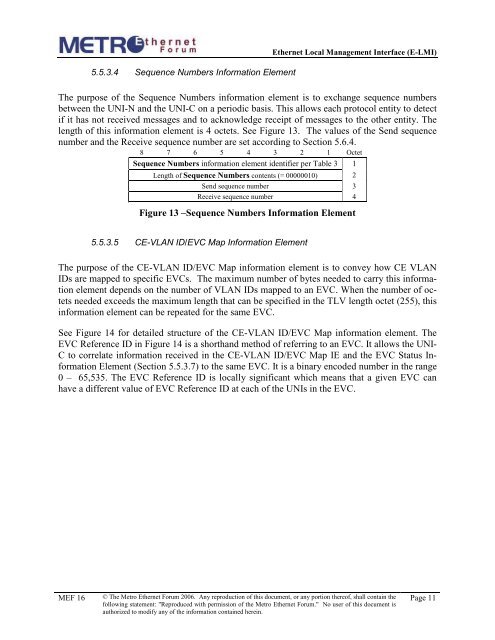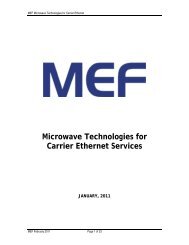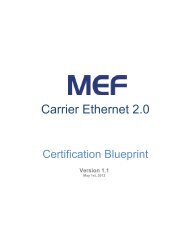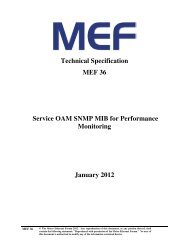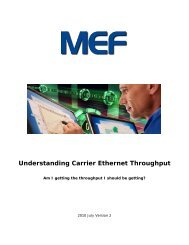Technical Specification MEF 16 Ethernet Local Management Interface
Technical Specification MEF 16 Ethernet Local Management Interface
Technical Specification MEF 16 Ethernet Local Management Interface
You also want an ePaper? Increase the reach of your titles
YUMPU automatically turns print PDFs into web optimized ePapers that Google loves.
5.5.3.4 Sequence Numbers Information Element<br />
<strong>Ethernet</strong> <strong>Local</strong> <strong>Management</strong> <strong>Interface</strong> (E-LMI)<br />
The purpose of the Sequence Numbers information element is to exchange sequence numbers<br />
between the UNI-N and the UNI-C on a periodic basis. This allows each protocol entity to detect<br />
if it has not received messages and to acknowledge receipt of messages to the other entity. The<br />
length of this information element is 4 octets. See Figure 13. The values of the Send sequence<br />
number and the Receive sequence number are set according to Section 5.6.4.<br />
8 7 6 5 4 3 2 1 Octet<br />
Sequence Numbers information element identifier per Table 3 1<br />
Length of Sequence Numbers contents (= 00000010) 2<br />
Send sequence number 3<br />
Receive sequence number 4<br />
Figure 13 –Sequence Numbers Information Element<br />
5.5.3.5 CE-VLAN ID/EVC Map Information Element<br />
The purpose of the CE-VLAN ID/EVC Map information element is to convey how CE VLAN<br />
IDs are mapped to specific EVCs. The maximum number of bytes needed to carry this information<br />
element depends on the number of VLAN IDs mapped to an EVC. When the number of octets<br />
needed exceeds the maximum length that can be specified in the TLV length octet (255), this<br />
information element can be repeated for the same EVC.<br />
See Figure 14 for detailed structure of the CE-VLAN ID/EVC Map information element. The<br />
EVC Reference ID in Figure 14 is a shorthand method of referring to an EVC. It allows the UNI-<br />
C to correlate information received in the CE-VLAN ID/EVC Map IE and the EVC Status Information<br />
Element (Section 5.5.3.7) to the same EVC. It is a binary encoded number in the range<br />
0 – 65,535. The EVC Reference ID is locally significant which means that a given EVC can<br />
have a different value of EVC Reference ID at each of the UNIs in the EVC.<br />
<strong>MEF</strong> <strong>16</strong><br />
© The Metro <strong>Ethernet</strong> Forum 2006. Any reproduction of this document, or any portion thereof, shall contain the<br />
following statement: "Reproduced with permission of the Metro <strong>Ethernet</strong> Forum." No user of this document is<br />
authorized to modify any of the information contained herein.<br />
Page 11


